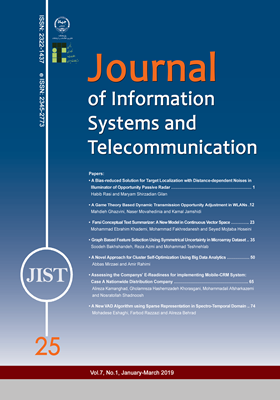-
-
List of Articles
-
Open Access Article
1 - A Bias-reduced Solution for Target Localization with Distance-dependent Noises in Illuminator of Opportunity Passive Radar
حبیب راثی Maryam Shirzadian Gilan -
Open Access Article
2 - A Game Theory Based Dynamic Transmission Opportunity Adjustment in WLANs
Mahdieh Ghazvini Kamal Jamshidi Naser Movahedinia -
Open Access Article
3 - Farsi Conceptual Text Summarizer: A New Model in Continuous Vector Space
Mohammad Ebrahim Khademi Mohammad Fakhredanesh Seyed Mojtaba Hoseini -
Open Access Article
4 - Graph Based Feature Selection Using Symmetrical Uncertainty in Microarray Dataset
Soodeh Bakhshandeh azmi azmi Mohammad Teshnehlab -
Open Access Article
5 - A Novel Approach for Cluster Self-Optimization Using Big Data Analytics
Abbas Mirzaei Amir Rahimi -
Open Access Article
6 - Assessing the Company's E-Readiness for Implementing Mobile-CRM System
Alireza Kamanghad Gholamreza Hashemzade Mohammadali Afshar kazemi Nosratollah Shadnoosh -
Open Access Article
7 - A New VAD Algorithm using Sparse Representation in Spectro-Temporal Domain
Mohadese Eshaghi Farbod Razzazi Alireza Behrad
-
The rights to this website are owned by the Raimag Press Management System.
Copyright © 2017-2025







